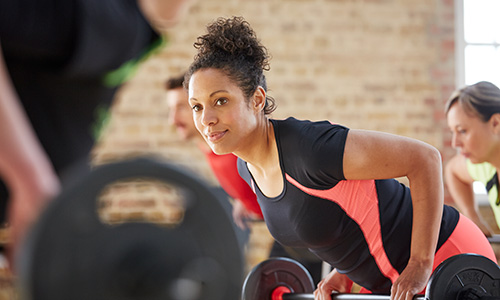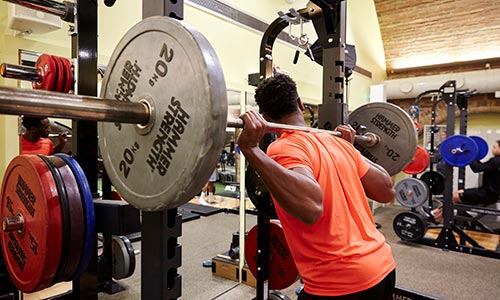The essential gym floor jargon buster
- Overview
Joining the gym can be daunting if you’re new to fitness. Even seasoned regulars can find it hard to keep up with changing jargon and terminology because new training methods and crazes are evolving all the time.
There’s no shame in asking questions and seeking explanations: at Nuffield Health there will always be professionals available to help. In the meantime, familiarising yourself with the lingo you might hear on the gym floor can be useful. Here’s our guide to common 'gym-speak'.
Types of training and classes

Aerobic: Moderate-intensity exercise that keeps your heart rate at 60 — 80 percent of its maximum rate.
Anaerobic: High-intensity ‘power’ exercise causing your heart rate to exceed 80 percent of its maximum rate.
Body combat: This is a non-contact martial arts style class that’s set to music.
Cardio: Cardiovascular exercise. This is moderate-intensity exercise that keeps your heart rate at 60 — 80 percent of its maximum rate. It's typically on a piece of gym equipment like a bike or a treadmill and usually completed in a time range.
Circuit training: A workout technique which involves moving quickly from one exercise to another and doing a set number of exercises at each ‘station.’
Crossfit: ‘CrossFit’ involves performing constantly varied functional movements at high intensity.
Functional training: Exercises that help with everyday living.
GX: This is short for ‘Group Exercise.’
HIIT: This is short for ‘High-Intensity Interval Training.’
LBT: This is short for ‘Legs, Bums and Tums’ and is often used to describe an exercise class that focuses on these areas.
Plyometrics: Plyometrics, ‘plyo’ or ‘jump training’ is a type of training that pairs maximum force with explosive movements.
Resistance training: This is a form of exercise that improves muscular strength and endurance. During a resistance training workout, you move your limbs against the resistance provided by your body weight, gravity, bands, weighted bars or dumbbells.
Tabata: A time-interval method of training that can be applied to any exercise. It's broken down into 20 seconds of activity and 10 seconds of rest, which is repeated eight times.
TRX: A form of suspension training that uses bodyweight exercises to develop strength, balance, flexibility and core stability simultaneously.
Find out more about fitness training types
Moves in gym training

AMRAP: This is short for ‘As Many Reps As Possible’.
Compound exercises: Exercises that use multiple muscle groups at the same time. For example, a squat.
Deadlifts: A full body exercise that involves lifting and lowering a bar, generally with a weight on each end, recruiting nearly every muscle in your body.
Drop sets: This strength-training technique involves switching to a lighter weight mid-set when your muscles get close to exhaustion, rather than stopping altogether.
Forced reps: These are reps performed at the end of a set when your muscles are at their failure point. It’s a tactic for creating extra gains in terms of strength and power.
High Impact: Exercises that put significant stress on your bones and joints.
Isolation exercises: These exercises target just one muscle group. Bicep curls are an example.
Pyramid reps: This training involves a slow, steady increase (or decrease) in intensity or repetitions throughout a workout.
Reps: Repetitions. A rep is the number of times you perform an exercise before resting. Therefore, one squat = one rep.
Supersets: Performing sets of two different exercises back to back without rest.
Gym floor equipment
Battle ropes: These are weighted ropes which offer full body strength training.
Kettles/Kettlebells: Kettlebells are a cast-iron or steel weight that looks a bit like a cannonball with a handle.
Plates: Flat weights that are fitted to a weight plate machine or put on a barbell.
Muscles and muscle groups

Bis/Pythons: The muscles on your upper arms between your shoulders and elbows.
Glutes: The three main muscles in your buttocks.
Hammies: The muscles at the back of your thighs.
Obliques: The muscles on each side of your body. The largest and most superficial of the abdominals.
Pecs: The thick muscles on your chest.
Quads: The muscles at the front of your thighs.
Traps: The muscles at the top of your back, either side of your neck.
Tris: The muscles at the back of your arms, between your shoulders and elbows.
Wings/Lats: The muscles at the sides of your back.
General gym lingo
Core: The muscles making up your abdominals, lower back, obliques, and hips.
Form: This refers the how you're performing an exercise — 'good form' means you're performing the exercise correctly.
Gains: This is another word for progress. It often refers to gaining muscle, but 'gains' can also be a way to describe your new running PB or loss of body fat.
PB: This is short for ‘Personal Best’ and can be used to describe to the best time, sets, reps or weight you’ve ever achieved.
Periodisation: This is the long-term cyclic structuring of your training plan, to coincide your best performance with important competitions.
Plateau: This occurs when you’re no longer seeing any 'gains' from your exercise.
PT: This is short for ‘Personal Trainer.’
WOD: This is short for ‘Workout of the Day.’
Scientific fitness terms

BMI: This is short for ‘Body Mass Index’ and is a measure of body fat in relation to weight and height. An ideal BMI is 18.5 – 24.9.
BMR: This is short for ‘Basal Metabolic Rate’. This is calculated using the number of calories your body burns per day while at complete rest and the minimum amount of calories you need to sustain life.
DOMS: This is short for ‘Delayed Onset of Muscular Soreness’, or that aching feeling you get a day or two after exercise.
Hypertrophy: An increase in muscle mass and an improvement in relative muscular strength. This is the opposite of atrophy, which is the loss or decrease of muscle mass.
Lactic acid: This is produced when you work muscles hard. A build-up of this normal by-product is what causes your muscles to fatigue during a workout.
MHR: This is short for ‘Maximum Heart Rate.’
Macros: Macronutrients. These are what make up the nutritional content of food, and are primarily responsible for producing the energy the body needs. The key macronutrients are carbohydrates, protein and fat.
Last updated Tuesday 20 September 2022
First published on Wednesday 27 March 2019

